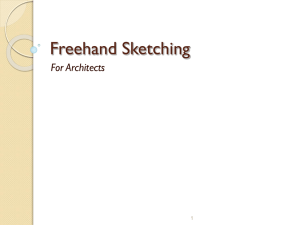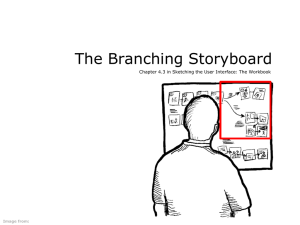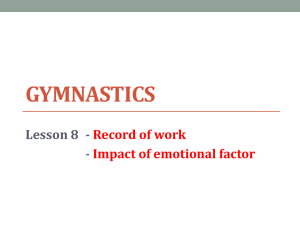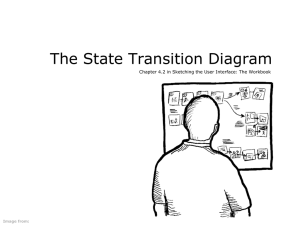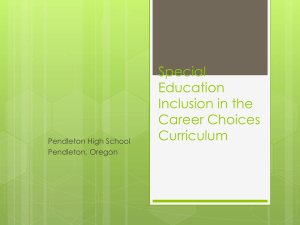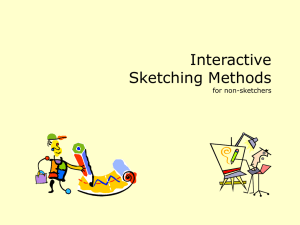Why should I sketch? - Sketching User Experiences: The Workbook
advertisement
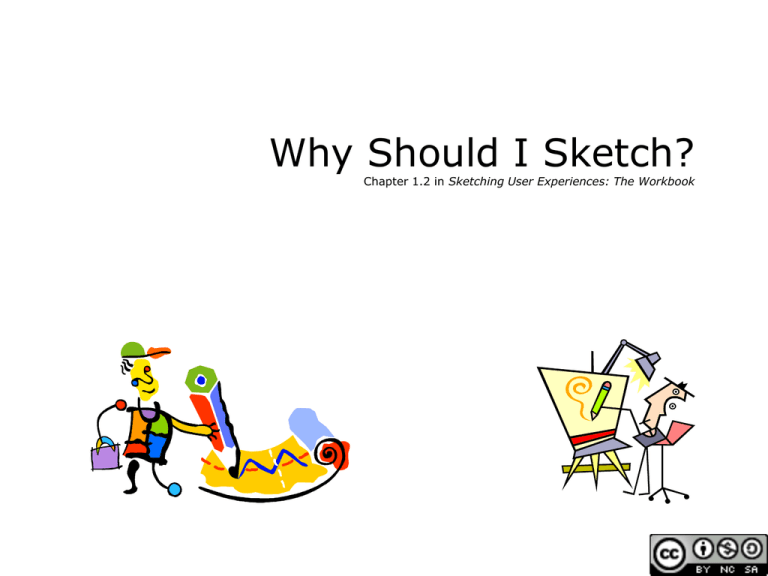
Why Should I Sketch? Chapter 1.2 in Sketching User Experiences: The Workbook Sketching is about Design Sketching is about design Sketching is not about drawing It is about design. Sketching is a tool to help you: o express o develop, and o communicate design ideas Sketching is part of a process: o o o o idea generation, design elaboration design choices, engineering Sketching User Experiences: The Workbook Why Sketch? • Create o o o o o o early ideation think openly about ideas think through ideas force you to visualize how things come together brainstorming: generate abundant ideas without worrying about quality invent and explore concepts • Record o ideas you develop o ideas that you come across o archive ideas for later reflection • Reflect, share, critique, decide o communicate ideas to others o invite responses, criticisms, and alternatives; o choose ideas worth pursuing Sketching User Experiences: The Workbook Exploring an idea Getting the Design Right Generate an idea Iterate and develop it Sketching User Experiences: The Workbook Exploring an idea Getting the Design Right Generate an idea Iterate and develop it But is it the best idea? Sketching User Experiences: The Workbook Exploring an idea Getting the Design Right Slide contributed by Bill Buxton Sketching User Experiences: The Workbook Exploring an idea Getting the Design Right The Problem fixates on first idea local hill climbing issue did you reach local vs. global maxima? Sketching User Experiences: The Workbook Exploring an idea Example: Cell phone design Iterative design Sketching User Experiences: The Workbook Exploring an idea Example: Cell phone design How do we get here with only iterative improvements? Sketching User Experiences: The Workbook Exploring alternatives Getting the Right Design1 … a designer that pitched three ideas would probably be fired. I'd say 5 is an entry point for an early formal review (distilled from 100's) … if you are pushing one you will be found out, and also fired … it is about open mindedness, humility, discovery, and learning. If you aren't authentically dedicated to that approach you are just doing it wrong! Alistair Hamilton VP Design Symbol Technologies 1Bill Buxton coined the expression ‘Getting the Design Right vs. Getting the Right Design’ Sketching User Experiences: The Workbook Exploring alternatives Getting the Right Design • • • • • • generate many ideas and variations reflect on all ideas choose the ones that look most promisting develop them in parallel add new ideas as they come up then iterate your final choice Sketching User Experiences: The Workbook Elaboration and Reduction • Elaborate - generate solutions. These are the opportunities • Reduce - decide on the ones worth pursuing • Repeat - elaborate and reduce again on those solutions Elaboration Reduction opportunity seeking decision-making Design process Source: Laseau,P. (1980) Graphic Thinking for Architects & Designers. John Wiley and Sons Sketching User Experiences: The Workbook Elaboration and Reduction Design is choice. There are two places where there is room for creativity 1. creativity you bring to enumerating meaningfully distinct options from which to choose 2. creativity you bring to defining the criteria, or heuristics, according to which you make your choices. Source: Laseau,P. (1980) Graphic Thinking for Architects & Designers. John Wiley and Sons Sketching User Experiences: The Workbook The Design Funnel • Alternate generation of ideas and convergence until resolution Modified from Pugh, S. (1990) Total design: Integrated methods for successful products engineering. Addison-Wesley. P. 75 Sketching User Experiences: The Workbook The Product View: The Statis Quo • product ideas judged at start • given red light (stop) or green light (go ahead) • product built, but may be deficient due to lack of design evolution Sketching User Experiences: The Workbook The Product View : Integrating Design • many designs considered in parallel • reduction filters and eliminates design until convergence • one or more designs can be considered for green light Sketching User Experiences: The Workbook The Product View: No Silos Actually an interplay between many different players Sketching User Experiences: The Workbook You now know 1. Sketching is about design, not just drawing 2. The design process • get the right design • then get that design right 3. The design funnel is • an interplay between elaboration and reduction • generate and elaborate designs • choose and reduce between designs 4. Design in product development • use the design funnel to develop ideas with the best ones considered for green/red light appraisal Sketching User Experiences: The Workbook Permissions You are free: • to Share — to copy, distribute and transmit the work • to Remix — to adapt the work Under the following conditions: • Attribution — You must attribute the work in the manner specified by the author (but not in any way that suggests that they endorse you or your use of the work) by citing: “from presentations accompanying the book ‘Sketching User Experiences, the Workbook’, by S. Greenberg, S. Carpendale, N. Marquardt and B. Buxton” • Noncommercial — You may not use this work for commercial purposes, except to assist one’s own teaching and training within commercial organizations. • Share Alike — If you alter, transform, or build upon this work, you may distribute the resulting work only under the same or similar license to this one. With the understanding that: • Not all material have transferable rights — materials from other sources which are included here are cited • Waiver — Any of the above conditions can be waived if you get permission from the copyright holder. • Public Domain — Where the work or any of its elements is in the public domain under applicable law, that status is in no way affected by the license. • Other Rights — In no way are any of the following rights affected by the license: • Your fair dealing or fair use rights, or other applicable copyright exceptions and limitations; • The author's moral rights; • Rights other persons may have either in the work itself or in how the work is used, such as publicity or privacy rights. Notice — For any reuse or distribution, you must make clear to others the license terms of this work. The best way to do this is with a link to this web page. Sketching User Experiences: The Workbook
